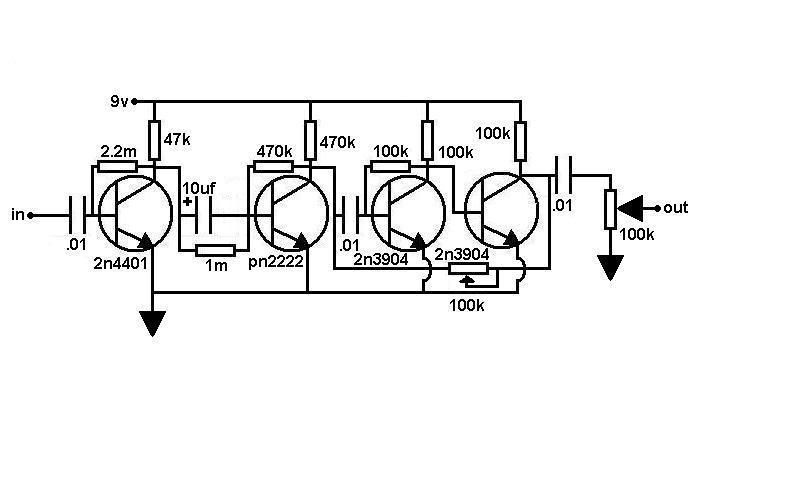Oh man, there's a huge rabbit hole here... forgive me for the long post, you've caught me mid-beer.
moid wrote:I find it hard to understand how the capacitor after the transistor blocks the current going to its collector
Capacitors block DC but pass AC, current is just the movement of electrons, and therefore exists in both AC and DC domains. For all intents and purposes, the DC elements we concern ourselves with (in this sort of thing - low level AC signal handling) are mainly just establishing potentials - which affect operational ranges of the actives - be they discrete transistors or IC opamps.
So, in short, the cap will pass the AC signal while blocking the DC potentials from one stage to the next.
moid wrote:Should I think of electrolytic capacitors as something to block / reduce voltage and the resistors would lower the volume of the audio?
In short: caps block DC and pass AC while resistors restrict or load down both class of signal.
Electrolytics are a somewhat special class of capacitor, in that they are an electro-chemical part as opposed to a strict physical geometry part; this results in a polar dissimilarity, so if you place it in circuit such that the DC potential of the negative side bears a positive voltage in relation to the positive leg of the part IT LEAKS LIKE A MOTHERFUCKER. How MUCH it leaks is going to largely hinge on the chemical composition of the electrolyte, and if you're ever in a pinch, placing two electrolytics + to + and treating them as a single part will create a non polarized capacitor.
You may not (as in: probably won't) run into them, but Tantalum caps are known to explode when installed polarity reversed, this is further exacerbated by the manufacturer's habit of putting the STRIPE on the POSITIVE lead. So if you wind up with little balloon looking things - pay attention.
moid wrote:Do other capacitor types have an effect on frequency passing then?
If you want to swim in polluted waters, you can research the opinions of people as to what different types of caps do to sound. TAKE IT ALL WITH A GRAIN OF SALT, and honestly, since you indicate you're just jumping in I would advise you to not concern yourself with that just yet...
What you SHOULD concern yourself with is value of the capacitor. A 100 pf cap will pass far more limited frequencies than a 10 uf cap (100,000 times larger value). Think of a cap as a short circuit for AC signal, which will ALWAYS favor higher frequencies and reach a point in which it will begin to act like a resistance to lower frequencies. So, the bigger the better, within reason - so far as AC is concerned. There's a complication regarding DC I'm going to gloss over since this is turning into a tome here. Suffice to say: slap any cap in there, if you lose bass response (and the cap is in SERIES with your signal path) raise the value, if you lose treble (and the cap is BLEEDING signal to ground) decrease your value.
No cap is perfect, and some people will get rabid about them, again, don't take anyone's opinion but your own too seriously.
moid wrote:And if I want to gate a signal, having a high value resistor that the audio path has to travel through would only allow the loudest signals through?
No. The resistor is a constant that will affect loud and soft levels more or less equally. What the resistor DOES do (one of its MANY functions) is set the bias level of a transistor. Imagine for a moment that you are the source signal, and the AC variation is essentially you jumping up and down on a trampoline.. now, the next stage is fed from line of sight, and it is a pie plate nailed to a tree. So long as you can see the pieplate, it will collect and deliver your signal to the next stage.
However, the next stage is some curmudgeonly old fuckwit who hates people looking at his pie plate, so he's built a fence between you, having fun on your trampoline, and his precious pie plate that is covered in ants and old cherry pie. RESISTORS define how tall that fence is, how tall the trampoline is, how springy the trampoline surface is, and the height of a branch that happens to be over your head is. Ideally, in the sense of hifi, the fence is low and the overhanging branch is high, and everything else is just right that you always have the pieplate in sight.
The gating/sputtering I think you're talking about is what happens when the fence is raised to the point at which you only see the pieplate part of the time, the remaining time NOTHING is conducted from point A to point B as you're stuck behind the wall. That is a function of DC bias, which *usually* hinges on resistance. Always a good idea to directly read voltage as a starting point though.
moid wrote:If that's true then maybe I could make a variable gate effect by using a potentiometer perhaps?
While the premise on which you extend this inquiry is incorrect, you can indeed affect bias with a pot. I would determine the lowest and highest useful voltage bias points on the base of the transistor, then plot that as a *ratio*, stick your 100K or whatever in a voltage divider so that the travel goes from one end of your useful range to the other.















